The impact of soil on bonsai root health cannot be overstated, setting the foundation for the entire tree’s vitality. Bonsai care intricately revolves around understanding the significance of the soil used, ensuring it meets the unique requirements of these miniature trees.
Unlike typical garden soil or potting soil, bonsai soil is specifically formulated to offer optimal drainage, aeration, and nutrient balance. Recognizing these differences is essential for anyone delving into the art of bonsai cultivation.
Understanding Bonsai Soil Composition
Bonsai, an art form that finds its roots (quite literally) in the harmony between the tree and its environment, necessitates a profound understanding of soil. At its core, soil serves as the medium of life for bonsai, impacting every aspect from nutrient absorption to water drainage.
The Interaction Of Soil And Roots
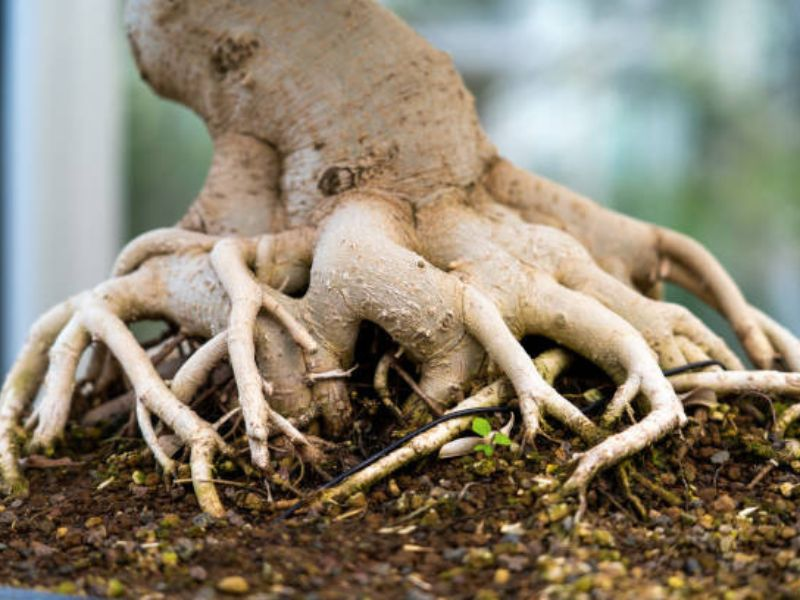
Bonsai roots are the lifeline of the tree, drawing both nourishment and anchorage from the soil. The components of a bonsai soil mix play a crucial role in ensuring these roots remain healthy and vibrant. How the soil mix interacts with roots isn’t merely a matter of providing nutrients; it’s about creating an environment where the roots can breathe, expand, and absorb water effectively.
Each ingredient in the soil mixture has a direct or indirect impact on root health. For instance, a well-aerated mix will promote robust root growth, preventing stagnation and ensuring the tree’s overall vitality. On the flip side, a poorly constituted mix can stifle root growth, depriving the tree of essential nutrients and leading to a host of health issues.
Bonsai Soil Mixtures
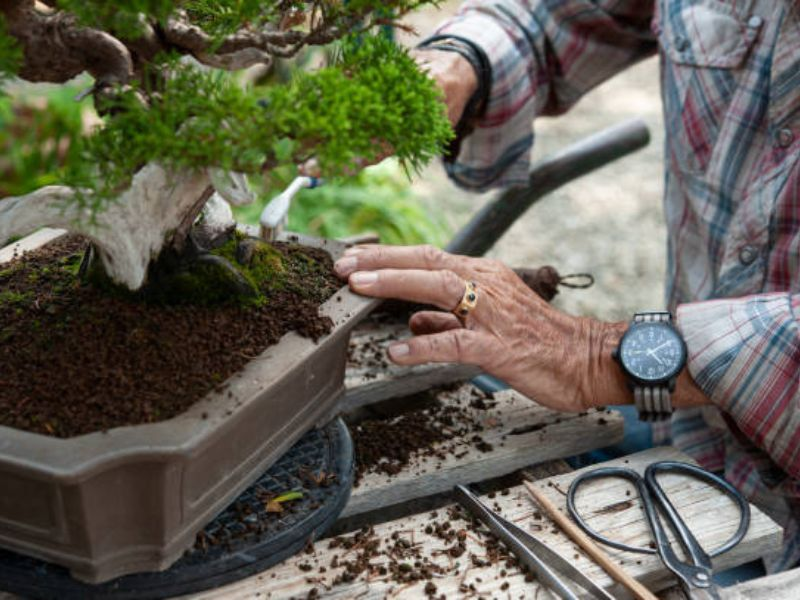
The essence of bonsai care revolves around understanding the dynamics of the soil mixture. It’s not about simply potting a tree in any available soil but choosing a mix that complements the tree’s natural habitat and growth patterns.
For example, lava rock, with its porous nature, ensures proper aeration and drainage, pivotal for preventing root rot and promoting healthy root growth. Peat moss, on the other hand, offers excellent water retention properties, ensuring the roots receive water in sufficient quantities without becoming waterlogged.
Different tree species might require variations in these components, making it imperative for enthusiasts to research and understand the unique soil needs of their chosen bonsai.
The Role Of Soil In Root Health
The relationship between soil and roots is symbiotic; the quality of one directly influences the health of the other.
Aeration And Root Growth
The effect of soil on bonsai root health is a critical aspect of soil health, particularly regarding proper aeration. A well-aerated soil ensures fresh air reaches the roots, which is pivotal for their respiration. Roots, much like the foliage above, need to breathe. If the soil is too compacted or dense, it can suffocate the roots, limiting their ability to absorb nutrients and oxygen.
Over time, this lack of aeration can eventually kill bonsai trees, turning an erstwhile vibrant tree into a withered remnant.
To envision this, imagine trying to breathe through a thick cloth—airflow is restricted, making it hard to get the oxygen you need. Similarly, bonsai roots, when trapped in compacted soil, struggle to access the air essential for their growth and health.
Water Retention And Drainage
While aeration is vital, so is the soil’s ability to retain and drain water. The root system of a bonsai is delicate and requires a balance between moisture and dryness. This is where the importance of drainage holes in bonsai pots comes into play. They ensure excess water can easily escape, preventing the roots from sitting in stagnant water.
Water retention in the soil is equally crucial. It ensures that roots have a steady supply of moisture, which aids in nutrient absorption. However, there’s a fine line between beneficial moisture and excess water.
Overly moist conditions, especially in the absence of proper drainage, can lead to root rot, a condition where the roots decay due to prolonged exposure to water. This not only affects the health of the roots but can, in severe cases, compromise the entire tree.
Practical Insights Into Bonsai Repotting And Soil
Repotting is a critical aspect of bonsai care, a ritual that ensures the tree continues to flourish in its miniature environment. This process isn’t just about changing the pot or renewing the soil; it’s a comprehensive approach to rejuvenate the tree, ensuring its roots remain healthy and the tree thrives for years to come.
Root Pruning
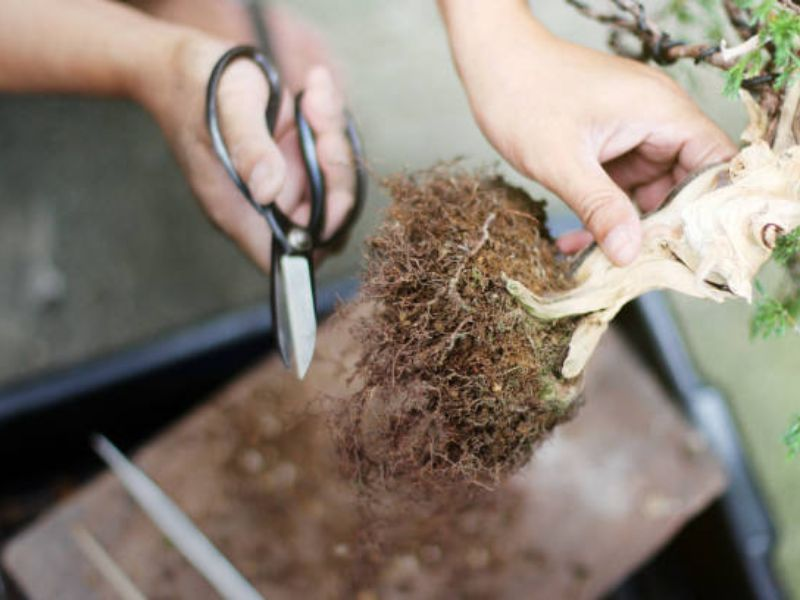
At the heart of the repotting process lies the art of root pruning. This is the practice of trimming away older, often thicker roots to promote the growth of newer, finer ones. Root pruning serves a dual purpose: it not only rejuvenates the tree by promoting fresh root growth but also prevents the bonsai from becoming root bound.
A root bound condition arises when the roots grow so densely that they entangle themselves, forming a thick root ball. This can stifle the bonsai’s growth, depriving it of essential nutrients and preventing proper aeration. Regular root pruning ensures that the roots have sufficient space to grow and breathe.
During the pruning process, a root hook can be an invaluable tool. This simple tool is designed to gently untangle and spread the roots, making it easier to prune without causing damage.
Selecting The Right Bonsai Pot
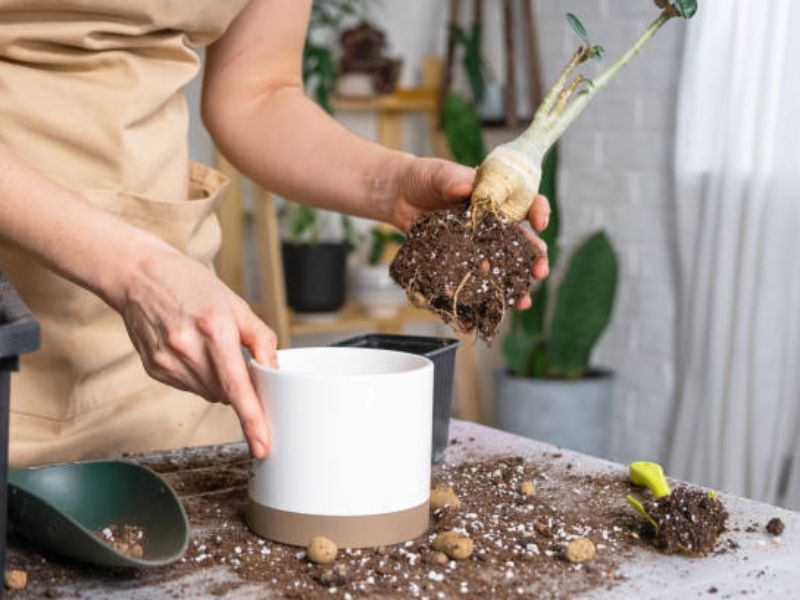
Not all bonsai pots are created equal. Selecting the right one can significantly impact the health and growth of your tree. Crucial considerations include:
- Size
- Depth
- Drainage
The influence of soil on bonsai root growth is a vital consideration, especially since different tree species have varying root growth patterns. This makes it essential to choose a pot that complements these patterns. For instance, a deep-rooted species might benefit from a deeper pot, while shallow-rooted ones might be better suited to wider, shallow pots.
Changing The Soil
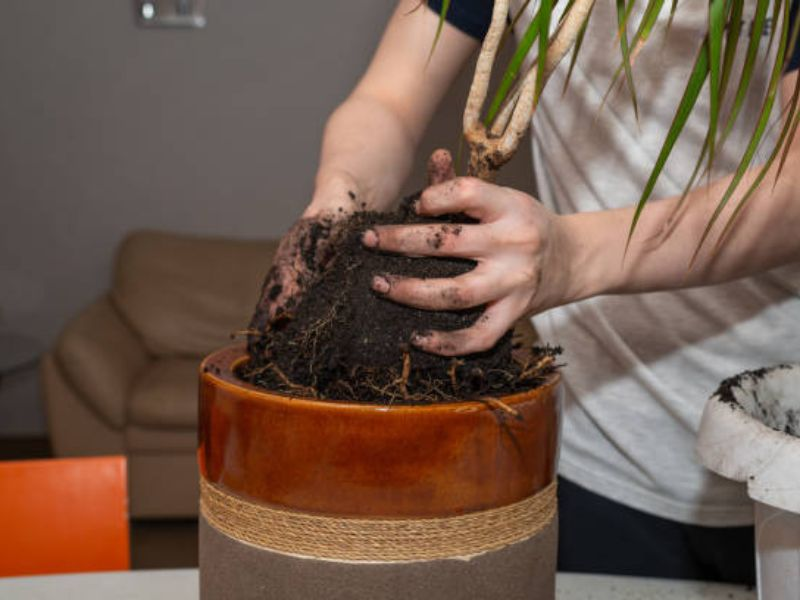
As time passes, the soil in which your bonsai resides can become exhausted, losing its essential nutrients. It might also become compacted, affecting its aeration properties. In such scenarios, it becomes imperative to replace the old soil with fresh soil.
One can choose to repot in the same pot after cleaning it and replacing the exhausted soil. This is especially beneficial if the tree has formed a harmonious relationship with its current pot. Alternatively, if the bonsai has outgrown its pot or if a change in aesthetics is desired, transitioning to a new pot can be considered.
Special Considerations For Different Bonsai Trees
Different species have unique requirements, and understanding these nuances can significantly elevate the art of bonsai care. Let’s delve into the particular needs of deciduous bonsai and the varied root structures of these miniature trees.
Deciduous Trees
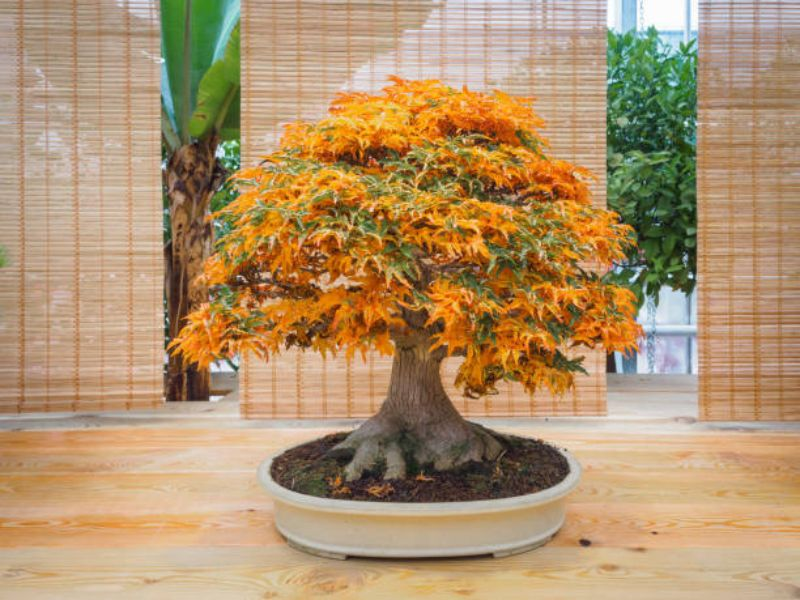
Deciduous bonsai species, like the trident maple, demand specific soil compositions to thrive. The soil must be adept at retaining enough moisture during growth periods while providing sufficient drainage to prevent root rot during dormancy.
Furthermore, these trees tend to have vigorous root systems, meaning the soil should also offer excellent aeration to accommodate and promote healthy root growth. It’s crucial to tailor the soil mix to the particular needs of these trees to ensure their optimal health and vibrant display during the growing season.
Root Characteristics Of Bonsai Trees
The intricate world below the bonsai pot is as varied and complex as the visible parts of the tree. Here’s a breakdown of the different root types and how soil impacts them:
- Surface Roots: These are the roots that are visible at the soil’s top layer. They play a significant role in nutrient and water absorption, making it vital to have a topsoil layer that isn’t too dense.
- Existing Roots: These are the established roots that have been part of the tree for some time. They play a foundational role in supporting the tree and need a stable soil structure for anchorage.
- Feeder Roots: As the name suggests, these roots are responsible for feeding the tree. They are the primary channels for water and nutrient uptake. A soil rich in nutrients with good water retention capabilities is ideal for these roots.
- Fine Roots: These delicate, thin roots are the tree’s growth frontier, constantly reaching out for nutrients. They thrive in well-aerated soils that prevent them from becoming suffocated or waterlogged.
Select The Best Bonsai Substrate For Optimal Growth
The art of bonsai cultivation extends far beyond the aesthetics of shaping and pruning. A significant, albeit often overlooked, component of this art lies beneath the surface: the substrate in which the bonsai grows. Choosing the right bonsai substrate is pivotal to the health, vitality, and overall success of the tree.
Why Bonsai Substrate Matters
The substrate is not just a medium to hold the tree in place. It’s the primary source of nutrients, a reservoir of moisture, and a facilitator of aeration for the bonsai’s roots. An optimal substrate ensures that the roots can breathe, access nutrients, and spread without hindrance.
Understanding Bonsai Substrate Components
Bonsai substrates are typically a blend of organic and inorganic materials. Each component serves a purpose:
- Organic Soil Components: These often include materials like “peat moss”, which helps retain moisture and provides a slow release of nutrients.
- Inorganic Soil Components: Elements such as lava rock are crucial for drainage and aeration. They ensure that the substrate doesn’t become waterlogged, preventing issues like root rot.
Making The Right Choice

The choice of bonsai substrate varies based on several factors:
- Tree Species: Different species have unique root systems and nutritional needs. What works for a Juniper may not be suitable for a Ficus.
- Climatic Conditions: The climate in which the bonsai is grown can influence the substrate choice. In humid conditions, a substrate with excellent drainage properties becomes vital.
- Pot Type: The type of pot, its depth, and its drainage capabilities can also influence the substrate selection.
Understanding the impact of soil on bonsai root health is crucial when investing time in selecting the right bonsai substrate. This can significantly impact your tree’s health and growth trajectory. It’s a foundational aspect of bonsai care, ensuring the tree’s roots have the best possible environment to thrive.





0 Comments